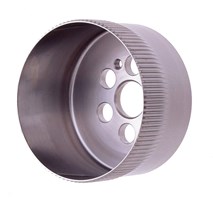HD 原理介紹
Strain Wave Gear Principle
Harmonic Drive® strain wave gearing utilizes a unique operating principle which is based upon the elastic mechanics of metals. The greatest benefits of harmonic strain wave gears are the zero-backlash characteristics and the weight and space savings compared to other gears because our gear mechanism consists of only three basic parts. They are the: Wave Generator, Flexspline and Circular Spline.
This simple three element construction combined with the unique operating principle allows extremely high reduction ratio in a very compact and lightweight package. Neither the size nor weight of the gear vary with the reduction ratio. The high performance attributes of this gearing technology including zero backlash, high torque, compact size, excellent positional accuracy and repeatability are all a direct result of the unique operating principle.
The strain wave gear was invented and patented in 1955 by a U.S. genius inventor, C. Walton Musser.
The Components
Wave Generator

The Wave Generator of the strain wave gear is comprised of a specially designed thin raced ball bearing that is fitted onto an elliptical hub. This serves as a high efficiency torque converter and is used as the input of the gear and is connected to the motor shaft.
Flexspline

The Flexspline is a thin cylindrical cup made from alloy steel with external teeth on the open end of the cup. The Flexspline is radially compliant but torsionally is very stiff. When the Wave Generator in inserted into the Flexspline the gear takes on its elliptical shape. The Flexspline is used as the output and is connected to the output flange.
Circular Spline

The Circular Spline is a rigid ring with internal teeth. When the gear is assembled it engages the teeth of the Flexspline across the major axis of the Wave Generator ellipse. The Circular Spline has two more teeth than the Flexspline and is fixed to the gear housing.
How it Works

Below is an exaggerated two-dimensional diagram demonstrating how the three gear elements engage and rotate.
The Flexspline is slightly smaller in diameter and has two fewer teeth than the Circular Spline. The elliptical shape of the Wave Generator causes the teeth of the Flexspline to engage the Circular Spline at two opposite regions across the major axis of the ellipse. For every 180 degree clockwise rotation of the Wave Generator the Flexspline teeth are advanced counterclockwise by one tooth in relation to the Circular Spline. Each complete clockwise rotation of the Wave Generator results in the Flexspline moving counter-clockwise by two teeth from its original position relative to the Circular Spline. Because the gear teeth are always fully engaged in a region along the major axis, Harmonic Drive® gearheads have Zero Backlash.

Superior Gear Performance Using an S Tooth Design
Harmonic Drive developed a unique gear tooth profile that optimizes the tooth engagement. It has a special curved surface unique to the S tooth profile that allows continuous contact with the tooth profile. It also alleviates the concentration of stress by widening the width of the tooth groove against the tooth thickness and enlarging the radius on the bottom. This tooth profile enables up to 30% of the total number of teeth to simultaneously. Additionally the large tooth root radius increases the tooth strength compared with an involute tooth. This technological innovation results in high torque, high torsional stiffness, long life and smooth rotation.



